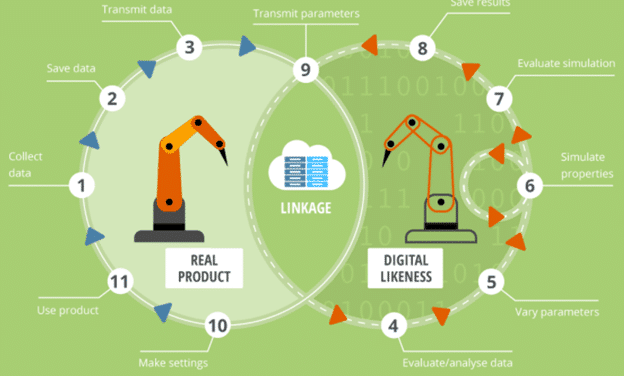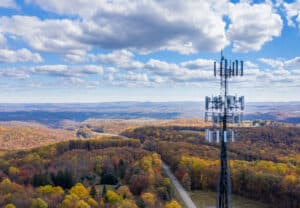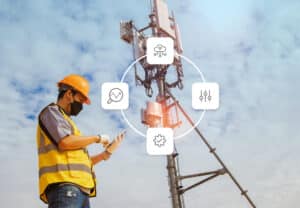
Digital twin software is a virtual simulation of remote or onsite physical assets using their sensor data in order to monitor and manage those devices and machines. These digital copies allow organizations to run in-depth analyses of this data and develop insights to maximize their machines’ operations and performance.
Benefits to using digital twin software
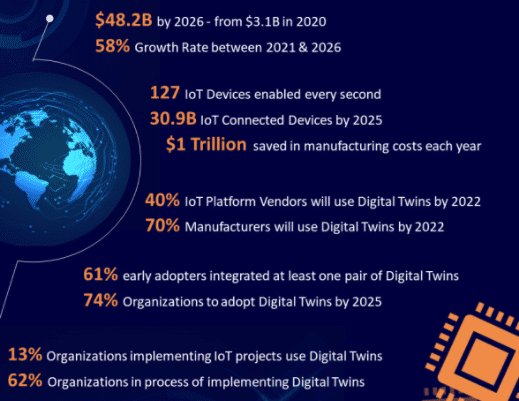
The digital twin software market is expected to grow from 3.1 billion in 2020 to reach nearly $50 billion by 2026. That explosive growth is part of a wide range of industries adopting digital twin software to optimize their business operations. This is in line with a recent survey that found
Digital twin software is capable of optimizing every aspect of business operations. This extends from predictive maintenance and errant activity alerts to intelligently reducing carbon emissions and increasing energy efficiency.
Digital twins can also provide early warnings to potential interruptions to operational continuity and understand where certain components in your infrastructure are behaving inefficiently. The ability to operate at scale regardless of geographic distance and area also provides a great solution to remote sites that are located in difficult to reach areas.
These digital twins can also be used to model site tower operations themselves, discovering areas to save on cost and reduce carbon footprint.
Challenges to using digital twin software
Digital twins are not always a perfect solution for every organization and site. The most important limitation is data. A digital twin will not work without a significant amount of historical and live data. Not every enterprise or group has enough data collected and stored to properly create a digital twin.
This also ties into another limitation, which is time. The intended application of digital twins means that the calculations and analyses need to be provided much faster than they would if dealt with in on-site. We still are limited in the capabilities of the data and analytics models in use today, which means the scope of these projects can also sometimes be limited.
In addition, the computing power and data analytics capabilities required to successfully execute a digital twin is massive, and this can be prohibitive to certain entities. Not every organization has the bandwidth, or a private or rented data center capable of processing and streaming such large quantities of data.
Finally, there is a serious issue of security ramifications for centralizing your data in one central point to run this simulation. Estimates by Gartner found that 3 in 4 digital twins for IoT-connected devices will require an average five different types of endpoints by just 2023. This makes standardization and synchronization of security controls drastically more difficult, and the potential security holes more numerous.
How do you create a digital twin?
A digital twin is unique to each entity site and organization. There is no one mold or true “template” for digital twins, but nearly all of them share a few common requirements.
The first thing you need is Data, and lots of it. Data models and structures are the lifeblood of a digital twin. They are a representation of the various processes and interrelations of various devices and assets within your infrastructure.
Next, you need is to give these data models something to work with, by adding knowledge, or rather, continuously collected data from your real-world machinery and energy assets. This is what will populate your simulation with an identical, manipulatable, digital twin.
To make this simulation work for you and provide actual value, the next step is to implement tools that can help remotely monitor, manage, and collect data on those physical assets. These vital tools include analytics models ranging from simple data collected to complex algorithms based on machine learning and big data.
Lastly, you need to have communication and interaction pathways and APIs setup to manipulate and interact with your digital twin. These connections will provide a direct interface to alter your digital twin and provide real-time changes in the physical world as a result of remote or human interaction.
Digital Twin Software In the Wild
Digital twin technology can be applied to many use cases in industrial sectors, including manufacturing and commercial properties. Using digital twin solutions, managers can have complete access to and control of machinery, including analyzing and adjusting performance in real-time.
The twin extends much farther than a single machine, however, and provides complete visibility over an entire manufacturing, commercial, or residential facility. This provides a much clearer picture of the operational process and reduces workload rather than analyzing singular machines or devices’ performance.
For telecommunications, digital twin software is able to simulate, monitor, and manage complex infrastructure to augment their performance live. Telecom requires complex layers of connected devices, spectrum bands, and various wireless and wired network connections. Digital twins are vital to understanding this ever-expanding network by simulating the impact of implementing certain changes, like 5G deployment.
In terms of tower management, visibility across thousands, tens, or even hundreds of thousands of remote tower sites is a daunting task. Digital twin software can create a manipulatable fully-visible network of your sites, including problem areas and potential events like theft, inefficiency, or required maintenance.
This simulation can also provide a wealth of actionable insights as technicians work on-site to understand what necessary fixes or upgrades may cause as a result of those changes. As these networks of sites grow, understanding how the placement of a certain site affects the surrounding area and the network overall is another great benefit of digital twin software.
How Galooli Provides Your Digital Twin for Remote Assets
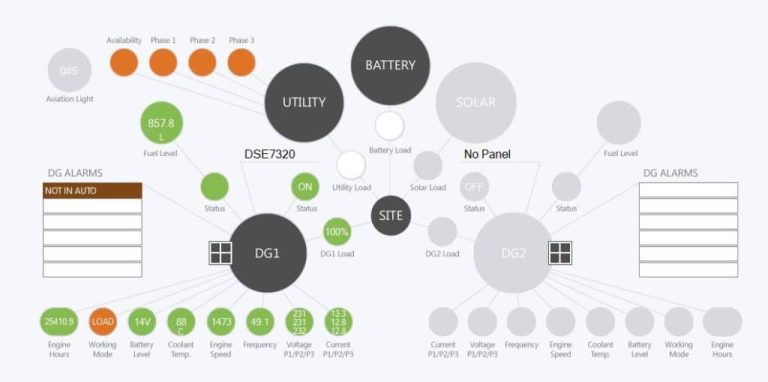
Galooli’s solution provides a digital twin of your remote sites and fleet assets, including energy sources. This twin can be manipulated and controlled from wherever a user is located, and immediately fix a problem without ever being on-site.
It also provides predictive analytics and live alerts for any unexpected activity or issues. Using our digital twin of your site, you can have full visibility over each and every remote asset you own, and singularly or as a group provide configuration and troubleshooting changes.
























